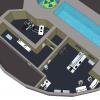Renaissance of the BNCT therapy
2015.09.05 15:08 - admin

Visualization of the new test facility for research on epithermal neutron beams exited from the MARIA reactor
The MARIA nuclear reactor operated in Świerk will soon be equipped with some new test facilities. NCBJ researchers are going to put in operation a lab dedicated for research on beams of epithermal neutrons. That will enable research on Boron-Neutron Capture Therapy (BNCT), a method to treat some cancer types, e.g. brain cancer.
International Congress organized on the occasion of 50 years of Polish Association of Medical Physics will be held at the premises of Warsaw University of Technology Faculty of Mechatronics between September 3 and 5, 2015. Topics to be discussed during scientific sessions include: radiation protection, radiotherapy, medical imaging, dosimetry, nanotechnology, nuclear medicine, education, new technologies. Some globally-recognized experts among the speakers include Hans-Georg Menzel, Chairman of the International Commission on Radiation Units and Measurements, Iiro Auterinen from VTT Technical Research Centre of Finland, and Akira Matsumura, Vice President and Executive Director for Medical Affairs of University of Tsukuba Hospital (Japan), a BNCT therapy expert. A workshop on the BNCT therapy will be held under the honorary patronage of the Małopolskie Region Voivode (Governor) in Cracow immediately just after the congress.
„Implementing in Świerk a project paving the way to research on BNCT therapy we have just followed global trends since that cancer treatment method has recently been experiencing a renaissance” – said Professor Grzegorz Wrochna, NCBJ Director General. „Due to its unique properties (such as an intense neutron flux) our MARIA research reactor is perfectly suited for such projects. That way we expect to become a leading w European research centre involved in BNCT research”.
Boron Neutron Capture Therapy is a method to effectively cure some cancer types, in particular brain tumours. Some boron-labelled organic substance preferentially absorbed by cancer cells (boron carrier) is administered to the patient. In about 2 hours the carrier molecules find their way into the cancer tissue. Then the patient is irradiated with a beam of epithermal neutron for a time on the order of an hour. Boron nuclei that have captured neutrons decay to lithium nuclei and emit some high-energy alpha particles. The latter destroy organic tissue in their vicinity, in effect killing cancer cells. Number of killed healthy cells is much smaller since the boron-labelled substance is preferentially absorbed by cancer cells. BNCT therapy is effective in treating polymorphic glioma, recurrent nape/neck lumps, colon cancer, or malignant melanoma.
Until recently, some research nuclear reactor was indispensable to apply the BNCT treatment. However, efforts to develop suitable neutron generators that could be operated just in oncology hospitals are currently under way in many countries all over the world (Japan, Argentina, Italy, China, Russia). First prototype devices are expected next year.
„Before physicians will start to treat their patients with BNCT, they must acquire specialized skills. To that end they have to attend some training courses, which practically may be organized only at the few currently operational research nuclear reactors in the world (under the supervision of nuclear physicists specializing in reactor physics). Just this might be a chance for us” – points out Eng. Michał Gryziński, PhD, Head of the NCBJ Mixed Radiation Dosimetry Lab. – „In Świerk we have been working on that topic for several months. Favourable technical conditions in our reactor to install an uranium converter capable to produce epithermal neutrons and to exit secondary beams of such neutrons are our greatest asset. NCBJ employs some highly valued Polish experts in research on boron carriers applicable in the BNCT therapy. It would be just unreasonable if the infrastructure, know-how, and representatives of various fields of engineering engaged in developmental works on that therapy available in Świerk were not taken advantage of!”
The „H2 Neutrons” project currently under accomplishment in NCBJ is aimed to develop two BNCT research set-ups at the MARIA reactor. Works on refurbishment of premises and installation of the uranium converter are under way. Świerk scientists expect that a beam of epithermal neutrons will become available next year. That will make possible on one hand to train BNCT therapy specialists in Poland, and on the other hand to research various BNCT therapy-related topics (beams of epithermal neutrons/boron carriers, optimal forms of therapy planning, radiation shielding materials/dosimetric gauges). Research on cell cultivations, methods to eradicate herpes spores and parasites (like nematodes) is also expected.


















